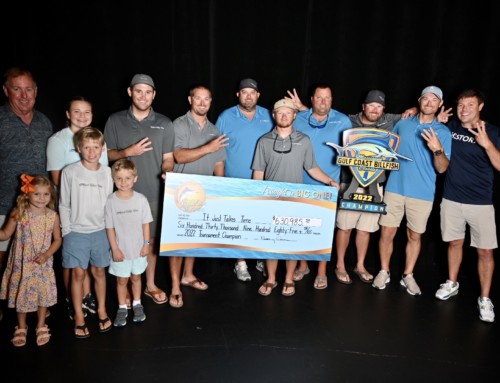By Capt. Dave Lear
February 27, 2013; Biloxi, Mississippi:
The weigh scales at the Classic are always a flurry of activity. Tournament staffers direct boat traffic, unload the fish, hoist them aloft and record the weights under the watchful eyes of the crowd looking on. But at the other end of the seawall, out of the spotlight, a small team works equally hard on another important task. They are the researchers and students of the University of Southern Mississippi’s Gulf Coast Research Laboratory, led by senior fisheries biologist Jim Franks. Franks has been involved with the tournament from the very start.
“The Classic has given us a great opportunity to collect biological samples over the years. We’ve focused on tuna, billfish, wahoo and dolphin in order to determine the age of the sampled fish, their reproductive patterns and other factors,” Franks explains. “We’ve collected a significant number of samples and those have enabled us to learn quite a bit about these species. The tournament is a great place for us to do our work.”
In addition to the tournament providing a venue and funding, others have helped support the lab’s sampling efforts as well. Franks acknowledges Sam Peters and Release Marine, Momoi Fishing Line and the Mobile Big Game Fishing Club for their additional financial support.
After the samples are collected, they are taken back to the lab for analysis. Biology students use them for advanced studies, too. Once the data has been compiled, Franks and his colleagues publish the findings in scientific journals. They also share the information with tournament anglers through presentations, slide shows and booths during the events.
Although the sampling varies from year to year, Franks says wahoo have been studied extensively, along with dolphin (also known as mahi or dorado) to confirm their growth rates, as well as spawning and feeding habits. Weighed blue marlin were also sampled to learn more about feeding habits and genetics. Tissue samples, otoliths or ear bones to determine age and fin clips for DNA testing are among the items collected from the fish. With a new three-year study just getting underway, yellowfin tuna will be targeted this season.
“We will be working with several groups on this new tuna study,” Franks says. “It’ll be very interesting research.” The focus will be on the tuna’s life span, genetics, growth, diet and reproduction cycles. Satellite tagging will plot the migration patterns of the species in the central gulf.
USM biologists Eric Saillant (genetics), Nancy Peterson (reproduction) and Dyan Gibson are also part of the team, along with Eric Hoffmayer (NOAA) and Jay Rooker (Texas A&M). The lead agency for the yellowfin study, the Louisiana Department of Wildlife and Fisheries, include Jennifer McKinney (satellite tagging), Cijii Marshall (dock sampling), Capt. Eric Newman and program manager Andy Fischer.
“This is collaboration between the scientists and the sport-fishing community,” Franks adds. “We really appreciate all the help the Classic and the anglers give us.”
So when you watch the proceedings at this year’s Classic weigh-in, keep in mind the scientific angle. It may not make the headlines, but the work of these dedicated biologists is vital to fisheries management–and the sport, nonetheless.


